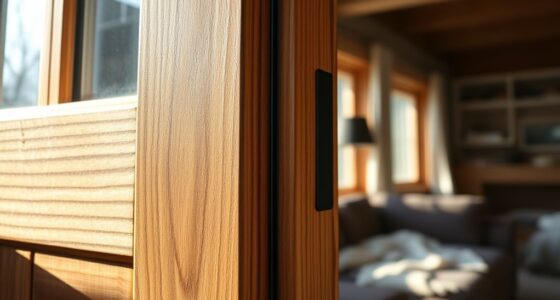To control humidity in your bathroom, guarantee proper ventilation with an exhaust fan that’s appropriately sized and vented outside. Opening windows and doors during and after showers also helps promote natural airflow. Combining these methods keeps moisture levels low, prevents mold growth, and reduces odors. Regular use of both strategies ensures a fresh, healthy space. Want to discover more tips? Keep exploring how you can optimize your bathroom’s ventilation for maximum comfort.
Key Takeaways
- Use exhaust fans properly sized for your bathroom to remove excess humidity effectively.
- Combine mechanical ventilation with natural airflow by opening windows and doors after use.
- Ensure exhaust fans vent directly outside to prevent humidity recirculation and mold growth.
- Regularly operate both exhaust fans and natural ventilation to maintain low humidity levels.
- Keep bathroom surfaces dry and well-ventilated to prevent mold, mildew, and moisture buildup.

Proper bathroom ventilation is essential for maintaining a fresh and healthy space. When you focus on effective ventilation, you help prevent mold growth, reduce moisture buildup, and keep odors at bay. One of the most reliable methods to achieve this is through exhaust fan installation. An exhaust fan actively pulls humid air out of your bathroom, especially after showers or baths, where moisture levels spike. Installing a quality exhaust fan is straightforward if you follow the right steps, and it can make a considerable difference in controlling humidity. Make sure to select a fan with adequate capacity for your bathroom size to ensure it can effectively remove excess moisture. Position the fan near the shower or bathtub, and vent it directly outside to prevent humidity from recirculating within your space.
But exhaust fans aren’t your only option. You can also leverage natural airflow to improve bathroom ventilation. Opening a window or door during and after showers creates a flow of fresh air that helps dry out moisture naturally. This approach is especially effective if your bathroom has a window that is easy to open and if the outdoor air quality is good. Combining natural airflow with mechanical ventilation provides a balanced approach, reducing humidity levels without relying solely on powered devices. If your bathroom lacks windows, installing an exhaust fan becomes even more critical, as it becomes your primary method for moisture removal.
To maximize the benefits of natural airflow, keep the bathroom door open when possible, especially during and after showers. This allows fresh air to circulate and helps carry away humidity. If outdoor conditions permit, opening a window during and after use can considerably decrease moisture levels. Remember, the key is to create a steady airflow that replaces stale, humid air with drier, fresher air from outside. This simple strategy can help prevent condensation buildup on mirrors, walls, and ceilings, which are common signs of poor ventilation.
In addition, choosing the right ventilation method based on your bathroom’s layout and climate can further optimize humidity control. Ultimately, a combination of exhaust fan installation and natural airflow provides the most effective humidity control. While an exhaust fan actively removes moisture, natural airflow enhances this process by introducing fresh air and encouraging circulation. Regularly using both methods ensures your bathroom remains dry, reducing mold and mildew risks, and maintaining good air quality. Properly ventilated bathrooms not only look better but also promote healthier living conditions. So, whether you’re installing an exhaust fan or opening a window, taking these steps will keep your bathroom fresh, dry, and comfortable.
Frequently Asked Questions
How Often Should Bathroom Vents Be Cleaned?
You should clean your bathroom vents every 6 to 12 months for proper ventilation maintenance. Regular cleaning helps prevent dust, mold, and debris buildup, ensuring ideal airflow and reducing humidity issues. If you notice reduced ventilation or musty odors, increase the cleaning frequency. Use a vacuum with a brush attachment or damp cloth to remove dirt and grime. Staying on top of ventilation maintenance keeps your bathroom fresh and prevents moisture-related problems.
Are There Energy-Efficient Ventilation Options?
You can’t afford to ignore energy-efficient ventilation options! Energy-saving fans drastically cut your power bills, saving you hundreds each year. Consider passive ventilation—it’s like having a silent hero working tirelessly behind your walls, reducing humidity without wasting energy. These eco-friendly choices not only protect your bathroom from mold but also help the planet. Upgrade today, and enjoy fresher air while dramatically lowering your energy use!
Can Ventilation Improve Indoor Air Quality?
Yes, ventilation can improve indoor air quality by removing pollutants, odors, and excess humidity. You should focus on effective ventilation design and incorporate air filtration systems to trap dust, allergens, and airborne particles. Proper airflow ensures fresh air circulates, reducing indoor pollutants. Regularly maintaining your ventilation system and using high-quality filters help keep your indoor environment healthier and more comfortable for everyone.
What Are Signs of Inadequate Bathroom Ventilation?
Like a cloud gathering in the sky, signs of inadequate bathroom ventilation include persistent moisture buildup on mirrors and walls, which can lead to mold growth. You might notice a lingering damp smell or paint peeling over time. Poor airflow causes this, so if humidity stays high even after showering, it’s a clear sign you need better ventilation. Addressing airflow issues helps keep your bathroom dry and mold-free.
How Does Humidity Affect Bathroom Mold Growth?
Humidity directly influences mold growth in your bathroom. When moisture isn’t properly vented, it creates an ideal environment for mold to thrive. High humidity levels promote mold prevention challenges, leading to visible spots and musty odors. To control moisture effectively, you should use exhaust fans, open windows, and maintain proper ventilation. Keeping humidity levels low helps prevent mold growth and keeps your bathroom fresh and healthy.
Conclusion
Think of your bathroom as a living garden; with proper ventilation and humidity control, you keep it thriving and fresh. When you guarantee good airflow and manage moisture, you’re watering your space with the right balance—preventing mold and odors from taking root. Just like a gardener tends to plants, you care for your bathroom’s health. Keep it well-ventilated, and watch your space stay bright, clean, and inviting every day.










